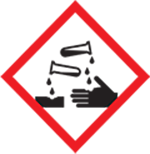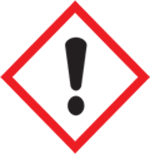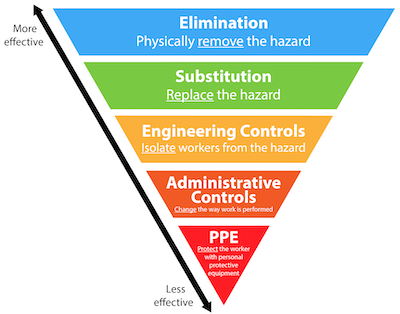Hydrochloric Acid
This chemical standard operating procedure (SOP) and the associated Safety Data Sheet (SDS) are for our safety. Read and understand both documents. If this is a paper copy, check for updated versions on the IsoLab website.
Process
We use hydrochloric acid in our percent carbonate method, kerogen extraction method, rock preparation process, cleaning syringes in our water isotope analysis methods, chromium reduction, and potentially to clean lab glassware.
Hazards - SDS


May be corrosive to metals. Causes severe skin burns and eye damage. May cause respiratory irritation.
Protection - SDS

Engineering Controls
Concentrated hydrochloric acid should only be used in a fume hood. Ensure the fume hood has proper air flow by checking the flow rate on the control panel and / or using a smoke match or wipe to visualize flow. Concentrations below 10% may be used outside of a fume hood.
Administrative Controls
If you are sharing a fume hood with someone and you will be working with concentrated hydrochloric acid, make certain they are aware you are using concentrated hydrochloric acid.
Personal Protective Equipment (PPE)
When working with concentrated hydrochloric acid, wear tightly fitting safety goggles, nitrile gloves, and a laboratory coat.
Handling - SDS
Keep container tightly closed when not in use. Make sure you have your laboratory coat, eye protection, and gloves on before handling the bottle.
Storage - SDS
In general, hydrochloric acid must be stored in 303B East Fume Hood Corrosives Cabinet. Use MyChem, the UW EH&S chemical inventory database, to find exactly where in the lab suite this chemical is stored. Store at room temperature and in the provided secondary containment within the corrosives cabinet.
Spills - SDS
Exposure:
- Inhalation - Remove person to fresh air and keep comfortable for breathing. Immediately call the Washington Poinson Center (800.222.1222) or a physician or 911.
- Skin contact - In case of skin contact, remove all contaminated clothing. Rinse skin with water / shower.
- Eye contact - Rinse cautiously with water for several minutes. Remove contact lenses, if present and easy to do. Continue rinsing. Immediately call the Washington Poison Center (800.222.1222) or a physician or 911.
If the spill is fully contained inside the fume hood, close the sash and prepare yourself to clean it up. Grab the closest spill kit. Make sure you have the appropriate PPE on (lab coat, nitrile gloves, eye protection). Do not allow the substance to enter the drain. Use liquid-absorbent material to soak up the chemical. Put all generated waste into a bag. See Waste section below.
If the spill is outside of the hood, do not breathe vapors and ensure adequate ventilation. Do not let anyone enter the contaminated space until the air is cleared or proper PPE has been donned.
If you need assistance or advice, use the IsoLab Emergency Contacts sheet.
Consult the EH&S Spill Poster and Exposure Poster
Waste - SDS
If you are cleaning up after a spill and have a bag of debris, ensure the bag is sealed and use multiple bags as needed. Complete an EH&S Hazardous Waste Label and adhere it to the bag. Here are instructions for how to label chemical waste containers. Labels are located in a drawer on the west wall of 303B near the door to the hallway.
If your waste is low concentration hydrochloric acid (e.g. 5-10%), you may choose to neutralize with sodium bicarbonate, measure the pH, and when neutral, pour down the drain. Complete an entry in the drain log.
If your hydrochloric acid is too concentrated or has other chemicals in it that can not go down the drain, use a waste container. Options for waste containers can be found under the west sink in 303B. Complete an EH&S Hazardous Waste Label and adhere it to the bottle. Here are instructions for how to label chemical waste containers. Labels are located in a drawer on the west wall of 303B near the door to the hallway.
Place the properly labeled container in one of the gray tubs near the hallway door of 303B. Segregate from other waste containers as appropriate.
Consult our generalized Chemical Waste Disposal SOP.
Training
hydrochloric acid is not deemed a particularly hazardous substance by EH&S and you do not need approval before using it. You do need to complete the list of requirements below before using this chemical.
Prerequisites
- You must have completed Managing Laboratory Chemicals in the last three years. Login to check.
- Read and understand the SDS for hydrochloric acid.
- Read, understand, and digitally sign this SOP.
